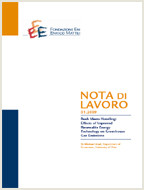Evaluating the Global Role of Woody Biomass as a Mitigation Strategy

20.04.2013
Alice Favero, Robert Mendelsohn
Q23, Q42, Q54
Bio-energy, Carbon Sequestration, Forestry, Integrated Assessment Model
Climate Change and Sustainable Development
Giuseppe Sammarco
As policy makers consider stringent targets for greenhouse gas emissions, integrated assessment models are increasingly relying on biomass energy as a critical energy source. However, it is not clear how much woody biomass to expect across time and across the planet. The integrated assessment models simply do not have enough detail about global forests and arable land to make careful forecasts of biomass supply over time. Integrating the complex dynamic demand for bioenergy from the IAMs with the complex dynamic structure of forests and forest supply is a daunting intertemporal task. This study examines the market for woody biomass by combining the integrated assessment model WITCH with the global dynamic forestry model GTM. Three carbon tax schedules are used to simulate different mitigation policies that lead to radiative forcing levels of 3.7, 3.2 and 2.5 W/m2 and a baseline scenario with no mitigation policies. WITCH determines the demand for woody biomass and GTM determines the supply of woody biomass over time. Moving from a mild to stringent mitigation policy would increase the demand of woody biomass from 8.2 to 15.2 billion m3/yr while the international price of wood would increase 4 to 9 times relative to the baseline scenario by 2100. This would shrink the demand for industrial wood products from 80% to 90% with the biomass program. Forest area will expand by 70-95% leading to increased storage of 685-1,279 GtCO2 in forest by 2100. Overall, the biomass program with the CCS technology plays a key contribution to overall GHG emission reductions in all scenarios contributing 20-27% of all mitigation for 2020-2100.
***
Suggested citation: Alice Favero and Robert Mendelsohn, Using Markets for Woody Biomass Energy to Sequester Carbon in Forests, Journal of the Association of Environmental and Resource Economists, Vol. 1, No. 1/2 (Spring/Summer 2014), pp. 75-95, DOI: 10.1086/676033
